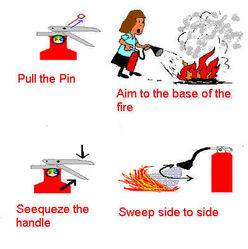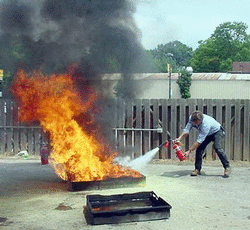How Fire Extinguishers Work
Fire needs fuel, oxygen and heat in order to burn. In simple terms, fire extinguishers remove one of these elements by applying an agent that either cools the burning fuel, or removes or displaces the surrounding oxygen.
Fire extinguishers are filled with water or a smothering material, such as CO2. By pulling out the safety pin and depressing the lever at the top of the cylinder (the body of the extinguisher), this material is released by high amounts of pressure.
At the top of the cylinder, there is a smaller cylinder filled with compressed gas. A release valve acts as a locking mechanism and prevents this gas from escaping. When you pull the safety pin and squeeze the lever, the lever pushes on an actuating rod which presses the valve down to open a passage to the nozzle. The compressed gas is released, applying a downward pressure on the fire-extinguishing material. This pushes the material out the nozzle with high amounts of pressure.
Although the temptation is to aim the extinguisher at the flames, the proper way to use the extinguisher is to aim it directly at the fuel.
Water Extinguishers
Water extinguishers are filled with regular tap water and pressurized with oxygen. The best way to remove heat is to dump water on the fire but, depending on the type of fire, this is not always the best option.
Dry Chemical Extinguishers
Dry chemical extinguishers are filled with either foam or powder, usually sodium bicarbonate (baking soda) or potassium bicarbonate, and pressurized with nitrogen. Baking soda is effective because it decomposes at 158 degrees Fahrenheit and releases carbon dioxide (which smothers oxygen) once it decomposes. Dry chemical extinguishers interrupt the chemical reaction of the fire by coating the fuel with a thin layer of powder or foam, separating the fuel from the surrounding oxygen.
Carbon Dioxide (CO2) extinguishers
CO2 extinguishers contain carbon dioxide, a non-flammable gas, and are highly pressurized. The pressure is so great that it is not uncommon for bits of dry ice to shoot out. CO2 is heavier than oxygen so these extinguishers work by displacing or taking away oxygen from the surrounding area. CO2 is also very cold so it also works by cooling the fuel.
Fire Extinguisher Types (What Kind do I use?)
With so many fire extinguishers to choose from, selecting the proper one for your home can be a daunting task. Everyone should have at least one fire extinguisher at home, but it's just as important to ensure you have the proper type of fire extinguisher. Fire protection experts recommend one for the kitchen, the garage and workshop.
Fire extinguishers are divided into four categories, based on different types of fires. Each fire extinguisher also has a numerical rating that serves as a guide for the amount of fire the extinguisher can handle. The higher the number, the more fire-fighting power. The following is a quick guide to help choose the right type of extinguisher.
* Class A extinguishers are for ordinary combustible materials such as paper, wood, cardboard, and most plastics. The numerical rating on these types of extinguishers indicates the amount of water it holds and the amount of fire it can extinguish.
* Class B fires involve flammable or combustible liquids such as gasoline, kerosene, grease and oil. The numerical rating for class B extinguishers indicates the approximate number of square feet of fire it can extinguish.
* Class C fires involve electrical equipment, such as appliances, wiring, circuit breakers and outlets. Never use water to extinguish class C fires - the risk of electrical shock is far too great! Class C extinguishers do not have a numerical rating. The C classification means the extinguishing agent is non-conductive.
* Class D fire extinguishers are commonly found in a chemical laboratory. They are for fires that involve combustible metals, such as magnesium, titanium, potassium and sodium. These types of extinguis
Fire needs fuel, oxygen and heat in order to burn. In simple terms, fire extinguishers remove one of these elements by applying an agent that either cools the burning fuel, or removes or displaces the surrounding oxygen.
Fire extinguishers are filled with water or a smothering material, such as CO2. By pulling out the safety pin and depressing the lever at the top of the cylinder (the body of the extinguisher), this material is released by high amounts of pressure.
At the top of the cylinder, there is a smaller cylinder filled with compressed gas. A release valve acts as a locking mechanism and prevents this gas from escaping. When you pull the safety pin and squeeze the lever, the lever pushes on an actuating rod which presses the valve down to open a passage to the nozzle. The compressed gas is released, applying a downward pressure on the fire-extinguishing material. This pushes the material out the nozzle with high amounts of pressure.
Although the temptation is to aim the extinguisher at the flames, the proper way to use the extinguisher is to aim it directly at the fuel.
Water Extinguishers
Water extinguishers are filled with regular tap water and pressurized with oxygen. The best way to remove heat is to dump water on the fire but, depending on the type of fire, this is not always the best option.
Dry Chemical Extinguishers
Dry chemical extinguishers are filled with either foam or powder, usually sodium bicarbonate (baking soda) or potassium bicarbonate, and pressurized with nitrogen. Baking soda is effective because it decomposes at 158 degrees Fahrenheit and releases carbon dioxide (which smothers oxygen) once it decomposes. Dry chemical extinguishers interrupt the chemical reaction of the fire by coating the fuel with a thin layer of powder or foam, separating the fuel from the surrounding oxygen.
Carbon Dioxide (CO2) extinguishers
CO2 extinguishers contain carbon dioxide, a non-flammable gas, and are highly pressurized. The pressure is so great that it is not uncommon for bits of dry ice to shoot out. CO2 is heavier than oxygen so these extinguishers work by displacing or taking away oxygen from the surrounding area. CO2 is also very cold so it also works by cooling the fuel.
Fire Extinguisher Types (What Kind do I use?)
With so many fire extinguishers to choose from, selecting the proper one for your home can be a daunting task. Everyone should have at least one fire extinguisher at home, but it's just as important to ensure you have the proper type of fire extinguisher. Fire protection experts recommend one for the kitchen, the garage and workshop.
Fire extinguishers are divided into four categories, based on different types of fires. Each fire extinguisher also has a numerical rating that serves as a guide for the amount of fire the extinguisher can handle. The higher the number, the more fire-fighting power. The following is a quick guide to help choose the right type of extinguisher.
* Class A extinguishers are for ordinary combustible materials such as paper, wood, cardboard, and most plastics. The numerical rating on these types of extinguishers indicates the amount of water it holds and the amount of fire it can extinguish.
* Class B fires involve flammable or combustible liquids such as gasoline, kerosene, grease and oil. The numerical rating for class B extinguishers indicates the approximate number of square feet of fire it can extinguish.
* Class C fires involve electrical equipment, such as appliances, wiring, circuit breakers and outlets. Never use water to extinguish class C fires - the risk of electrical shock is far too great! Class C extinguishers do not have a numerical rating. The C classification means the extinguishing agent is non-conductive.
* Class D fire extinguishers are commonly found in a chemical laboratory. They are for fires that involve combustible metals, such as magnesium, titanium, potassium and sodium. These types of extinguis





